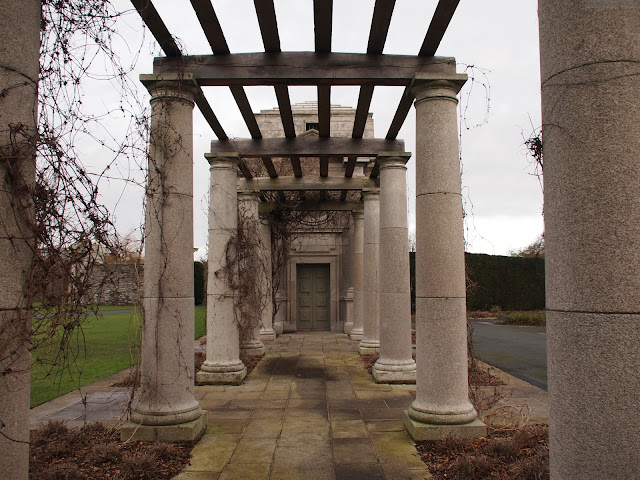Awaiting those who venture beyond the simple entranceway is the Irish National War Memorial Gardens, a beautiful expanse of trees, sunken gardens, and monuments, all replete with symbolism.
 |
| The view from the top of the main stairway. |
 |
| As you descend, looking left and right, you notice the stone facades of the other pathways are reminiscent of bunkers. |
 |
| The Great Cross with its truncated arms. |
 |
Just beyond the Great Cross, and perfectly aligned with it, is the symbolic altar of the War Stone. Crafted from seven and a half tons
of Irish granite, the dimensions of the stone are identical to War Stones, in First World War memorials throughout the world.
War Stones are sometimes referred to using the more benign term 'Stone of Remembrance'.
The inscription reads 'Their Name Liveth For Evermore'. |
 |
One of two broad fountain basins to the left and right of the War Stone. The obelisk at the centre symbolizes a candle. Beyond the fountains
are two of the Book rooms. On the left, way off in the distance, you can see the top of Wellington's monument in Phoenix Park. |
 |
| Two of four aptly named Book Rooms. Within the book rooms are housed the Books of Remembrance in which are inscribed the names of the 49,400 Irish soldiers who were killed in the First World War. There is one book room for each of the four provinces of Ireland. Like so many of the elements here, these rooms are crafted of granite. Also, secreted away in one of the rooms is the Ginchy Cross, a 4 metre high (13ft) wooden celtic cross which was erected on the Somme in 1917. The cross stood as a memorial to the 4,354 men of the 16th Irish Division who were killed on the Somme in 1916 during two battles, one at Ginchy and one at Guillemont. The cross was brought back to Ireland in 1926, and locked away here. In its place in France a stone cross stands. |
 |
| Beneath the pergola between two of the Book Rooms. The layout and construction of the other Book Rooms is identical. |
 |
| To the left and right of the central lawn, and just beyond each set of Book Rooms, lie sunken rose gardens. At the heart of each one is a small lily pond. It had been the intent of the gardens' architect Edwin Lutyens to create these sunken gardens as a tranquil place for meditation free from any allusions to military symbolism. |
 |
| Down another set of stairs, and again perfectly aligned with both the War Stone and the Great Cross, this tree lined avenue leads to a dome 'temple'. A number of tree lined avenues radiate out from the site of the temple. |
 |
| Looking back through the temple to the Great Cross. |
 |
| Underfoot inside the temple, the words of English poet and soldier Rupert Brooke. |
Copyright©irisheyesjg2013.
Click on images to view larger versions.
Reference:
Irish National War Memorial Gardens Visitors Guide, Office of Public Works, Ireland.
See also:
Commemoration in the landscape: The Irish National War Memorial Gardens.







Brilliant you did the place proud, shame it is forgotten. The great cross is called the cross of sacrifice on Commonwealth war grave sites.
ReplyDeleteHi Bill,
DeleteThanks for your lovely comments; they are very much appreciated.
While the Great Cross here is similar to the Great Cross of Sacrifice, there are three distinct differences. As the CWG website specifies, those crosses which bear the name ‘The Great Cross of Sacrifice’ only stand over burial grounds in which the remains of members of the military are interred. They are always crafted of Portland Stone, the stone of which military gravestones are made, and they always have a bronze sword attached which spans the arms and upper body of the cross. The cross in this memorial is made of Irish granite, bears no sword, and the gardens are not a burial ground, thus it is simply named The Great Cross.
Cheers,
Jennifer
A beautiful place for contemplating family history. I'll add it to my buck list. Interesting to know about the crosses. I saw some at sights in France when my parents took us there long ago when I was a surly teenager and didn't properly appreciate it. Great photos Jenn.
ReplyDeleteHi Charlotte,
DeleteThanks for your comments; they are always much appreciated. I think we were all surly teenagers at some point. :):) You'll have to go back to France and revisit some of those places.
Cheers,
Jennifer
What a beautiful tranquil place, and lovely photos, as usual, Jennifer. I'm enjoying my tour of Ireland "with" you - I've only been twice for long weekends so missed out on an awful lot! Jo
ReplyDeleteHi Jo,
DeleteThanks for your comments. Lovely to hear from you and glad you're enjoying the photos. Hope all is well with you and yours.
Cheers,
Jennifer
You've introduced me to many places I've never visited in Ireland, Jennifer so I'll be kept busy "next time". Thank you for sharing your knowledge with all of us.
ReplyDeleteHi Pauleen,
DeleteThanks very much for your comments; they are much appreciated. There are still so many places I'd like to visit too. That old saying has just popped into my head: 'too many places, too little time'.
Cheers,
Jennifer